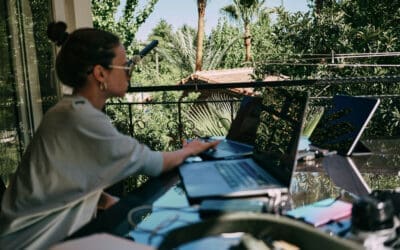The coffee shop Wi-Fi’s finally cooperating, your laptop battery’s at 87%, and you’ve just closed a client project that’ll fund your next three months in Bali. Life as a digital nomad has its moments of perfection. But what if that client work wasn’t your only income source? What if your crypto holdings were in the background, generating revenue while you explored night markets or caught that perfect sunrise?
You’re not alone in seeking this freedom. American digital nomads surged to 16.9 million in 2022—a 131% jump from 5 years ago. With 43% planning extended stays abroad, traditional banking systems simply haven’t kept pace with our borderless lifestyle. That’s where cryptocurrency enters the picture, not as some get-rich-quick fantasy, but as a practical tool for location independence. Casually checking Bitcoin price USD and acting on it is becoming another form of freedom. Something that many are undertaking as part of their daily lives.
Let’s explore three proven approaches to generating passive crypto income that won’t require a computer science degree, the tax realities you absolutely must understand, and where this intersection of technology and freedom might be headed next.
Low-Maintenance Money Makers
Remember when earning interest meant dealing with brick-and-mortar banks and rates that barely covered inflation? Those days feel increasingly distant for crypto-savvy nomads.
Staking and lending represent the entry points most digital wanderers should consider first. They’re essentially the crypto equivalent of putting your money to work—though with considerably more interesting results than your hometown savings account could ever deliver.
“So what’s the difference?” I hear you asking. With staking, you’re essentially locking up your coins to help secure a blockchain network. In return, you receive rewards. It’s passive in the truest sense—set it up and check in occasionally while the network does the heavy lifting. Platforms now offer upwards of 5% on USDC staking, which might not sound revolutionary until you compare it to traditional savings rates.
Lending works differently. You’re allowing others to borrow your crypto assets through platforms that handle the matchmaking and risk management. The beauty lies in its predictability—the interest income remains relatively stable while you retain ownership of your underlying assets.
When selecting platforms, don’t just chase the highest advertised yields. Look for established reputations, significant Total Value Locked (TVL), and third-party audit histories. For nomads particularly, cross-border accessibility matters tremendously—what good is a high-yield platform that freezes when you cross a national border?
I’ve found that Bitcoin and stablecoins like USDC and USDT offer the sweet spot—highest yields with minimal price volatility. That stability matters when you’re calculating exactly how many months your passive income might fund your stay in Portugal or Thailand.
Higher Risk, Higher Reward
Once you’ve gotten comfortable with basic staking and lending, yield farming represents the next frontier—though it comes with a learning curve that shouldn’t be underestimated.
Yield farming involves moving your assets between different protocols to maximize returns. Think of it as being an unusually nimble farmer who can instantly transport crops to whichever field is most fertile at any given moment. Some platforms claim daily earnings reaching $1,000 through sophisticated strategies, though I’d suggest approaching such figures with healthy skepticism.
The key to sustainable yield farming isn’t chasing the highest momentary returns but understanding the mechanics behind them. Why is a particular pool offering 20% when others offer 5%? There’s always a reason, and it usually involves risk.
Smart contract audits matter enormously here. Higher TVL generally indicates more scrutiny of the underlying code, but never mistake popularity for security. The most successful nomad yield farmers I’ve known treated due diligence as part of their job—not an optional extra.
Diversification becomes crucial at this level. Moving all your assets into a single high-yield opportunity creates vulnerability that can erase months of careful gains in minutes. Spreading your strategies across platforms doesn’t just reduce risk—it creates resilience that complements the nomadic lifestyle itself.
The Tax Man Cometh (Even in Paradise)
Let’s talk about the conversation many digital nomads avoid until it’s too late: taxes on crypto income.
Your crypto earnings fall into three main categories, each with distinct tax treatments:
- Income tax applies to crypto received for services based on fair market value when received
- Capital gains tax hits when you sell or trade cryptocurrency at a profit
- Self-employment tax (15.3% in the US before regular income tax) applies to crypto earned through freelance work
The biggest trap I’ve seen fellow nomads fall into? Misunderstanding the infamous “183-day rule” that many countries use to determine tax residency. Stay somewhere longer than 183 days, and you might unexpectedly establish tax residency—potentially creating obligations in multiple jurisdictions simultaneously.
Track your travel meticulously. Document which earnings occurred where. Consult with tax professionals familiar with both crypto and expatriate situations. The freedom cryptocurrency offers quickly diminishes when you’re facing unexpected tax bills from countries you visited two years ago.
This isn’t meant to discourage you—just the opposite. Understanding these obligations upfront lets you plan appropriately. After all, isn’t planning for freedom what being a digital nomad is all about?
Protecting Your Nomad Portfolio
The intersection of digital nomadism and cryptocurrency won’t remain static—it’s evolving faster than either component individually.
AI-powered automation continues reshaping both finance and content creation, opening doors for passive income streams that barely existed months ago. Sustainable Bitcoin mining using renewable energy sources is becoming standard practice rather than the exception. DeFi adoption increasingly looks mainstream rather than fringe.
What particularly fascinates me? The emergence of tokenized physical assets and cross-chain solutions. The arbitrary divisions between blockchains are gradually dissolving, creating interconnected ecosystems where your assets can move seamlessly between opportunities. For nomads who already value borderless living, these borderless financial systems feel like a natural extension of our existing philosophy.
Your Passport to Financial Freedom Has New Stamps
The beauty of cryptocurrency for digital nomads isn’t about overnight wealth. It’s about alignment with the values that likely drew you to location independence in the first place: autonomy, flexibility, and freedom from arbitrary limitations.
The digital nomad population grew 131% for good reason—we’ve collectively realized that work can happen anywhere. Now our money can work anywhere too. The infrastructure exists. The opportunities are verified. The question isn’t whether cryptocurrency can enhance your nomadic lifestyle—it’s whether you’re ready to add this particular stamp to your financial passport.
Read Next
Goal Map and Vision Board the New Year!
How to Use a Passion Planner and a Look Into Mine From This Year!
ThriveCart Review. Why I Love It & You Should Too
My Top 5 Reasons You Should Use ActiveCampaign in Your Business
How to Set Quarterly Goals: My System for Massive Success
My Sales Process and Discovery Call Script
How to Create an Online Sales Funnel
Motivation Tips for Entrepreneurs
How to Overcome Shiny Object Syndrome
2-3x Your Business Revenue Using These 5 Strategies
How to Price Yourself: Tips, Tricks, and Common Mistakes
When and What to Outsource in Your Business











